
Thomas Fairfax was born at Denton Hall, near Otley, Yorkshire, on 17 January 1612, the eldest son of Ferdinando, Lord Fairfax. 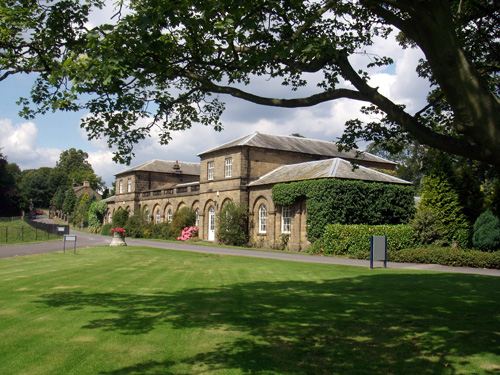 He studied at St John's College, Cambridge,[and Gray's Inn (1626–28), then volunteered to join Sir Horace Vere's expedition to fight for the Protestant cause in the Netherlands. In 1639 he commanded a troop of Yorkshire dragoons which marched with King Charles I against the Scots in the First Bishops' War which ended with the Pacification of Berwick before any fighting took place. In the Second Bishops' War the following year the English army was routed at the battle of Newburn.
He studied at St John's College, Cambridge,[and Gray's Inn (1626–28), then volunteered to join Sir Horace Vere's expedition to fight for the Protestant cause in the Netherlands. In 1639 he commanded a troop of Yorkshire dragoons which marched with King Charles I against the Scots in the First Bishops' War which ended with the Pacification of Berwick before any fighting took place. In the Second Bishops' War the following year the English army was routed at the battle of Newburn. 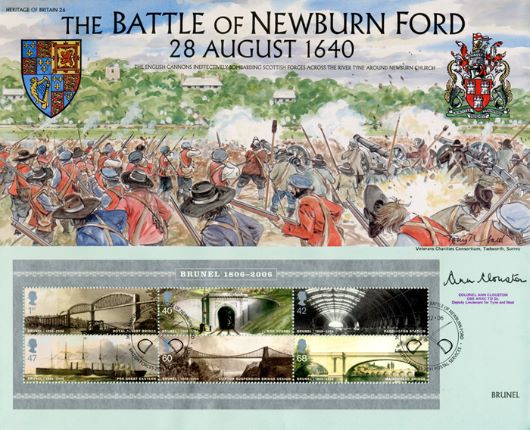 Fairfax fled with the rest of the defeated army but was nevertheless knighted for his services in January 1641.
Fairfax fled with the rest of the defeated army but was nevertheless knighted for his services in January 1641.
 He studied at St John's College, Cambridge,[and Gray's Inn (1626–28), then volunteered to join Sir Horace Vere's expedition to fight for the Protestant cause in the Netherlands. In 1639 he commanded a troop of Yorkshire dragoons which marched with King Charles I against the Scots in the First Bishops' War which ended with the Pacification of Berwick before any fighting took place. In the Second Bishops' War the following year the English army was routed at the battle of Newburn.
He studied at St John's College, Cambridge,[and Gray's Inn (1626–28), then volunteered to join Sir Horace Vere's expedition to fight for the Protestant cause in the Netherlands. In 1639 he commanded a troop of Yorkshire dragoons which marched with King Charles I against the Scots in the First Bishops' War which ended with the Pacification of Berwick before any fighting took place. In the Second Bishops' War the following year the English army was routed at the battle of Newburn.  Fairfax fled with the rest of the defeated army but was nevertheless knighted for his services in January 1641.
Fairfax fled with the rest of the defeated army but was nevertheless knighted for his services in January 1641.
The Fairfaxes, father and son, though serving at first under King Charles I, were opposed to the arbitrary prerogative of the Crown, and Sir Thomas declared that "his judgment was for the Parliament as the king and kingdom's great and safest council".  When Charles endeavoured to raise a guard for his own person at York, intending it, as the event afterwards proved, to form the nucleus of an army, Fairfax was employed to present a petition to his sovereign, entreating him to hearken to the voice of his parliament, and to discontinue the raising of troops. This was at a great meeting of the freeholders and farmers of Yorkshire convened by the king on Heworth Moor near York. Charles evaded receiving the petition, pressing his horse forward, but Fairfax followed him and placed the petition on the pommel of the king's saddle.
When Charles endeavoured to raise a guard for his own person at York, intending it, as the event afterwards proved, to form the nucleus of an army, Fairfax was employed to present a petition to his sovereign, entreating him to hearken to the voice of his parliament, and to discontinue the raising of troops. This was at a great meeting of the freeholders and farmers of Yorkshire convened by the king on Heworth Moor near York. Charles evaded receiving the petition, pressing his horse forward, but Fairfax followed him and placed the petition on the pommel of the king's saddle.
 When Charles endeavoured to raise a guard for his own person at York, intending it, as the event afterwards proved, to form the nucleus of an army, Fairfax was employed to present a petition to his sovereign, entreating him to hearken to the voice of his parliament, and to discontinue the raising of troops. This was at a great meeting of the freeholders and farmers of Yorkshire convened by the king on Heworth Moor near York. Charles evaded receiving the petition, pressing his horse forward, but Fairfax followed him and placed the petition on the pommel of the king's saddle.
When Charles endeavoured to raise a guard for his own person at York, intending it, as the event afterwards proved, to form the nucleus of an army, Fairfax was employed to present a petition to his sovereign, entreating him to hearken to the voice of his parliament, and to discontinue the raising of troops. This was at a great meeting of the freeholders and farmers of Yorkshire convened by the king on Heworth Moor near York. Charles evaded receiving the petition, pressing his horse forward, but Fairfax followed him and placed the petition on the pommel of the king's saddle.When the civil war broke out in 1642, his father, Lord Fairfax, was appointed general of the Parliamentary forces in the north, and Sir Thomas was made lieutenant-general of the horse under him. Both father and son distinguished themselves in the campaigns in Yorkshire.
Sometimes severely defeated, more often successful, and always energetic, prudent and resourceful, they contrived to keep up the struggle until the crisis of 1644, when York was held by the Marquess of Newcastle  against the combined forces of the English Parliamentarians and the Scots, and Prince Rupert hastened with all available forces to its relief. A gathering of eager national forces within a few square miles of ground naturally led to a battle, and Marston Moor (2 July 1644) proved decisive for the struggle in the north. The younger Fairfax bore himself with the greatest gallantry in the battle, and though severely wounded managed to join Oliver Cromwell and the victorious cavalry on the other wing. One of his brothers, Colonel Charles Fairfax, was killed in the action. But the Marquess of Newcastle fled the kingdom, and the Royalists abandoned all hope of retrieving their affairs. The city of York was taken, and nearly the whole north submitted to the Parliament.
against the combined forces of the English Parliamentarians and the Scots, and Prince Rupert hastened with all available forces to its relief. A gathering of eager national forces within a few square miles of ground naturally led to a battle, and Marston Moor (2 July 1644) proved decisive for the struggle in the north. The younger Fairfax bore himself with the greatest gallantry in the battle, and though severely wounded managed to join Oliver Cromwell and the victorious cavalry on the other wing. One of his brothers, Colonel Charles Fairfax, was killed in the action. But the Marquess of Newcastle fled the kingdom, and the Royalists abandoned all hope of retrieving their affairs. The city of York was taken, and nearly the whole north submitted to the Parliament.
In the south and west of England, however, the Royalist cause was still strong. The war had lasted two years, and the nation began to complain of the contributions that were exacted, and the excesses that were committed by the military. Dissatisfaction was expressed with the military commanders, and, as a preliminary step to reform, the Self-denying Ordinance was passed. This involved the removal of the Earl of Essex from the supreme command, along with other Members of Parliament. This was followed by the New Model Ordinance, which replaced the locally raised Parliamentary regiments with a unified army. Sir Thomas Fairfax was selected as the new lord general with Cromwell as his lieutenant-general and cavalry commander.  against the combined forces of the English Parliamentarians and the Scots, and Prince Rupert hastened with all available forces to its relief. A gathering of eager national forces within a few square miles of ground naturally led to a battle, and Marston Moor (2 July 1644) proved decisive for the struggle in the north. The younger Fairfax bore himself with the greatest gallantry in the battle, and though severely wounded managed to join Oliver Cromwell and the victorious cavalry on the other wing. One of his brothers, Colonel Charles Fairfax, was killed in the action. But the Marquess of Newcastle fled the kingdom, and the Royalists abandoned all hope of retrieving their affairs. The city of York was taken, and nearly the whole north submitted to the Parliament.
against the combined forces of the English Parliamentarians and the Scots, and Prince Rupert hastened with all available forces to its relief. A gathering of eager national forces within a few square miles of ground naturally led to a battle, and Marston Moor (2 July 1644) proved decisive for the struggle in the north. The younger Fairfax bore himself with the greatest gallantry in the battle, and though severely wounded managed to join Oliver Cromwell and the victorious cavalry on the other wing. One of his brothers, Colonel Charles Fairfax, was killed in the action. But the Marquess of Newcastle fled the kingdom, and the Royalists abandoned all hope of retrieving their affairs. The city of York was taken, and nearly the whole north submitted to the Parliament.
 After a short preliminary campaign the "New Model" justified its existence, and "the rebels' new brutish general", as the king called him, proved his capacity as commander-in-chief in the decisive victory of Naseby (14 June 1645). The king fled to Wales. Fairfax besieged Leicester, and was successful at Taunton, Bridgwater and Bristol. The whole west was soon reduced.
After a short preliminary campaign the "New Model" justified its existence, and "the rebels' new brutish general", as the king called him, proved his capacity as commander-in-chief in the decisive victory of Naseby (14 June 1645). The king fled to Wales. Fairfax besieged Leicester, and was successful at Taunton, Bridgwater and Bristol. The whole west was soon reduced.
Fairfax arrived in London on 12 November 1645. In his progress towards the capital he was accompanied by applauding crowds. Complimentary speeches and thanks were presented to him by both houses of parliament, along with a jewel of great value set with diamonds, and a sum of money. The king had returned from Wales and established himself at Oxford, where there was a strong garrison, but, ever vacillating, he withdrew secretly, and proceeded to Newark to throw himself into the arms of the Scots. Oxford capitulated following the final siege of Oxford,
Complimentary speeches and thanks were presented to him by both houses of parliament, along with a jewel of great value set with diamonds, and a sum of money. The king had returned from Wales and established himself at Oxford, where there was a strong garrison, but, ever vacillating, he withdrew secretly, and proceeded to Newark to throw himself into the arms of the Scots. Oxford capitulated following the final siege of Oxford, 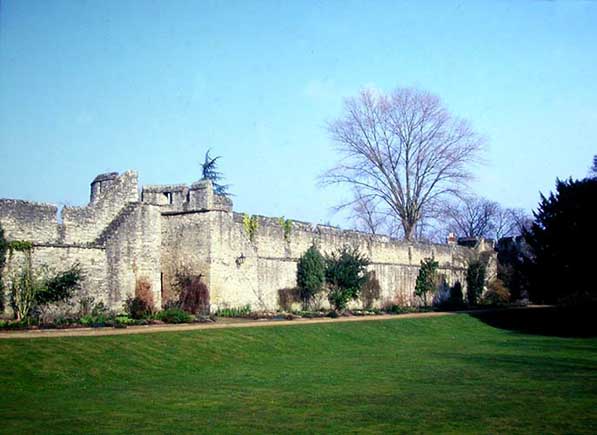
and by the end of September 1646 Charles had neither army nor garrison in England, following the surrender of Thomas Blagge at Wallingford Castle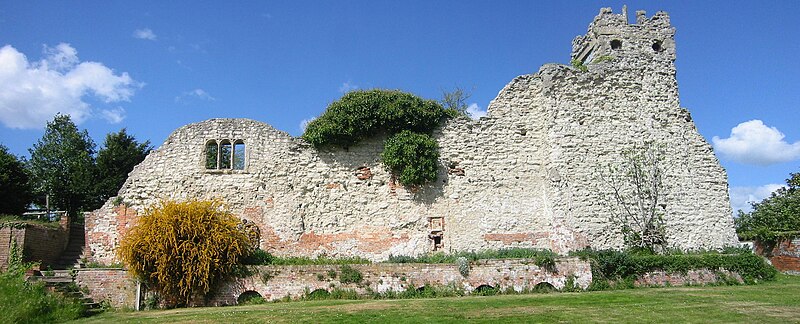 after a siege conducted by Fairfax. In January 1647 he was delivered up by the Scots to the commissioners of parliament. Fairfax met the king beyond Nottingham, and accompanied him during the journey to Holdenby, treating him with the utmost consideration in every way. "The general", said Charles, "is a man of honour, and keeps his word which he had pledged to me."
after a siege conducted by Fairfax. In January 1647 he was delivered up by the Scots to the commissioners of parliament. Fairfax met the king beyond Nottingham, and accompanied him during the journey to Holdenby, treating him with the utmost consideration in every way. "The general", said Charles, "is a man of honour, and keeps his word which he had pledged to me."

 Complimentary speeches and thanks were presented to him by both houses of parliament, along with a jewel of great value set with diamonds, and a sum of money. The king had returned from Wales and established himself at Oxford, where there was a strong garrison, but, ever vacillating, he withdrew secretly, and proceeded to Newark to throw himself into the arms of the Scots. Oxford capitulated following the final siege of Oxford,
Complimentary speeches and thanks were presented to him by both houses of parliament, along with a jewel of great value set with diamonds, and a sum of money. The king had returned from Wales and established himself at Oxford, where there was a strong garrison, but, ever vacillating, he withdrew secretly, and proceeded to Newark to throw himself into the arms of the Scots. Oxford capitulated following the final siege of Oxford, 
and by the end of September 1646 Charles had neither army nor garrison in England, following the surrender of Thomas Blagge at Wallingford Castle
 after a siege conducted by Fairfax. In January 1647 he was delivered up by the Scots to the commissioners of parliament. Fairfax met the king beyond Nottingham, and accompanied him during the journey to Holdenby, treating him with the utmost consideration in every way. "The general", said Charles, "is a man of honour, and keeps his word which he had pledged to me."
after a siege conducted by Fairfax. In January 1647 he was delivered up by the Scots to the commissioners of parliament. Fairfax met the king beyond Nottingham, and accompanied him during the journey to Holdenby, treating him with the utmost consideration in every way. "The general", said Charles, "is a man of honour, and keeps his word which he had pledged to me."
With the collapse of the Royalist cause came a confused period of negotiations between the Parliament and the king, between the king and the Scots, and between the Presbyterians and the Independents in and out of Parliament. In these negotiations the New Model Army soon began to take a most active part. The lord general was placed in the unpleasant position of intermediary between his own officers and Parliament. To the grievances, usual in armies of that time, concerning arrears of pay and indemnity for acts committed on duty, there was quickly added the political propaganda of the Independents, and in July the person of the king was seized by Cornet Joyce,
 a subaltern of cavalry — an act which sufficiently demonstrated the hopelessness of controlling the army by its articles of war. It had, in fact, become the most formidable political party in the realm, and pressed straight on to the overthrow of Parliament and the punishment of Charles.
a subaltern of cavalry — an act which sufficiently demonstrated the hopelessness of controlling the army by its articles of war. It had, in fact, become the most formidable political party in the realm, and pressed straight on to the overthrow of Parliament and the punishment of Charles.
Fairfax was more at home in the field than at the head of a political committee, and, finding events too strong for him, he sought to resign his commission as commander-in-chief. He was, however, persuaded to retain it. He thus remained the titular chief of the army party, and with the greater part of its objects he was in complete, sometimes most active, sympathy. Shortly before the outbreak of the Second Civil War, Fairfax succeeded his father in the barony and in the office of governor of Hull. In the field against the English Royalists in 1648 he displayed his former energy and skill, and his operations culminated in the successful siege of Colchester, after the surrender of which place he approved the execution of the Royalist leaders Sir Charles Lucas and Sir George Lisle, holding that these officers had broken their parole. At the same time Cromwell's great victory of Preston crushed the Scots, and the Independents became practically all-powerful
holding that these officers had broken their parole. At the same time Cromwell's great victory of Preston crushed the Scots, and the Independents became practically all-powerful

 holding that these officers had broken their parole. At the same time Cromwell's great victory of Preston crushed the Scots, and the Independents became practically all-powerful
holding that these officers had broken their parole. At the same time Cromwell's great victory of Preston crushed the Scots, and the Independents became practically all-powerful
John Milton, in a sonnet written during the siege of Colchester, called upon the lord general to settle the kingdom, but the crisis was now at hand. Fairfax was in agreement with Cromwell and the army leaders in demanding the punishment of Charles, and he was still the effective head of the army. He approved, if he did not take an active part in, Pride's Purge (6 December 1648), 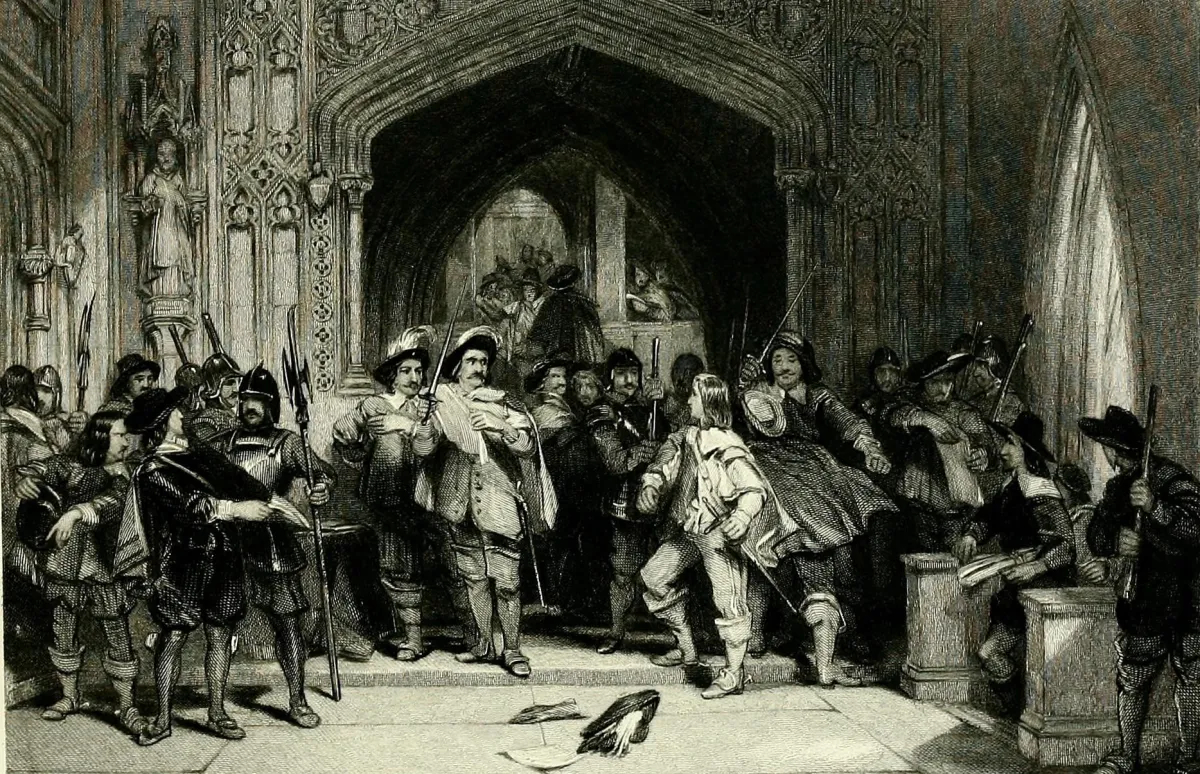 but on the last and gravest of the questions at issue he set himself in deliberate and open opposition to the policy of the officers. He was placed at the head of the judges who were to try the king, and attended the preliminary sitting of the court. Then, convinced at last that the king's death was intended, he refused to act. In calling over the court, when the crier pronounced the name of Fairfax, a lady in the gallery called out that the Lord Fairfax was not there in person, that he would never sit among them, and that they did him wrong to name him as a commissioner. This was Lady Fairfax, who could not forbear, as Bulstrode Whitelocke says, to exclaim aloud against the proceedings of the High Court of Justice.
but on the last and gravest of the questions at issue he set himself in deliberate and open opposition to the policy of the officers. He was placed at the head of the judges who were to try the king, and attended the preliminary sitting of the court. Then, convinced at last that the king's death was intended, he refused to act. In calling over the court, when the crier pronounced the name of Fairfax, a lady in the gallery called out that the Lord Fairfax was not there in person, that he would never sit among them, and that they did him wrong to name him as a commissioner. This was Lady Fairfax, who could not forbear, as Bulstrode Whitelocke says, to exclaim aloud against the proceedings of the High Court of Justice.

 but on the last and gravest of the questions at issue he set himself in deliberate and open opposition to the policy of the officers. He was placed at the head of the judges who were to try the king, and attended the preliminary sitting of the court. Then, convinced at last that the king's death was intended, he refused to act. In calling over the court, when the crier pronounced the name of Fairfax, a lady in the gallery called out that the Lord Fairfax was not there in person, that he would never sit among them, and that they did him wrong to name him as a commissioner. This was Lady Fairfax, who could not forbear, as Bulstrode Whitelocke says, to exclaim aloud against the proceedings of the High Court of Justice.
but on the last and gravest of the questions at issue he set himself in deliberate and open opposition to the policy of the officers. He was placed at the head of the judges who were to try the king, and attended the preliminary sitting of the court. Then, convinced at last that the king's death was intended, he refused to act. In calling over the court, when the crier pronounced the name of Fairfax, a lady in the gallery called out that the Lord Fairfax was not there in person, that he would never sit among them, and that they did him wrong to name him as a commissioner. This was Lady Fairfax, who could not forbear, as Bulstrode Whitelocke says, to exclaim aloud against the proceedings of the High Court of Justice.
His last service as commander-in-chief was the suppression of the Leveller mutiny at Burford in May 1649.

The Banbury mutiny was a mutiny by soldiers in the English New Model Army. The mutineers did not achieve all of their aims and some of the leaders were executed shortly afterwards on May 17, 1649.
 . The pay issue was defused by Oliver Cromwell acknowledging the justice of the soldiers' financial grievances and securing £10,000 towards payment of arrears from Parliament. But 400 troopers under the command of Captain William Thompson who were sympathetic to the Levellers set off from Banbury, where they were billeted to speak with other regiments at Salisbury about their political demands.
. The pay issue was defused by Oliver Cromwell acknowledging the justice of the soldiers' financial grievances and securing £10,000 towards payment of arrears from Parliament. But 400 troopers under the command of Captain William Thompson who were sympathetic to the Levellers set off from Banbury, where they were billeted to speak with other regiments at Salisbury about their political demands.
Major White was sent by Cromwell and Thomas Fairfax to mediate with Thompson's troops and give assurances that force would not be used against them. However on May 13 Cromwell launched a night attack. Several mutineers were killed in the skirmish. Captain Thompson escaped only to be killed a few days later in another skirmish near the Diggers community at Wellingborough.  After being imprisoned in Burford Church with the other mutineers,three other leaders were shot: Cornet James Thompson (William Thompson's brother), Corporal Perkins and John Church on May 17, 1649.This destroyed the Levellers' power base in the New Model Army.Each year since 1975, Levellers' Day has been held in the Oxfordshire town of Burford to commemorate the three Levellers executed there.
After being imprisoned in Burford Church with the other mutineers,three other leaders were shot: Cornet James Thompson (William Thompson's brother), Corporal Perkins and John Church on May 17, 1649.This destroyed the Levellers' power base in the New Model Army.Each year since 1975, Levellers' Day has been held in the Oxfordshire town of Burford to commemorate the three Levellers executed there.
The Diggers were a group of Protestant English agrarian communists,[begun by Gerrard Winstanley
as True Levellers in 1649, who became known as Diggers due to their activities.
Their original name came from their belief in economic equality based upon a specific passage in the Book of Acts.The Diggers tried (by "levelling" real property) to reform the existing social order with an agrarian lifestyle based on their ideas for the creation of small egalitarian rural communities. They were one of a number of nonconformist dissenting groups that emerged around this time.
They were one of a number of nonconformist dissenting groups that emerged around this time.

A different theme is chosen for each Levellers' Day and speakers are invited to speak on the theme during the morning, this is followed by a procession around the town and a ceremony in the churchyard. In the afternoon there is music and other entertainment usually held in the garden of Warwick Hall which is next to the church.
In 1979 a plaque to the three soldiers on the church wall was unveiled by Tony Benn to commemorate the event
 After being imprisoned in Burford Church with the other mutineers,three other leaders were shot: Cornet James Thompson (William Thompson's brother), Corporal Perkins and John Church on May 17, 1649.This destroyed the Levellers' power base in the New Model Army.Each year since 1975, Levellers' Day has been held in the Oxfordshire town of Burford to commemorate the three Levellers executed there.
After being imprisoned in Burford Church with the other mutineers,three other leaders were shot: Cornet James Thompson (William Thompson's brother), Corporal Perkins and John Church on May 17, 1649.This destroyed the Levellers' power base in the New Model Army.Each year since 1975, Levellers' Day has been held in the Oxfordshire town of Burford to commemorate the three Levellers executed there.The Diggers were a group of Protestant English agrarian communists,[begun by Gerrard Winstanley

as True Levellers in 1649, who became known as Diggers due to their activities.
Their original name came from their belief in economic equality based upon a specific passage in the Book of Acts.The Diggers tried (by "levelling" real property) to reform the existing social order with an agrarian lifestyle based on their ideas for the creation of small egalitarian rural communities.
 They were one of a number of nonconformist dissenting groups that emerged around this time.
They were one of a number of nonconformist dissenting groups that emerged around this time.
A different theme is chosen for each Levellers' Day and speakers are invited to speak on the theme during the morning, this is followed by a procession around the town and a ceremony in the churchyard. In the afternoon there is music and other entertainment usually held in the garden of Warwick Hall which is next to the church.
In 1979 a plaque to the three soldiers on the church wall was unveiled by Tony Benn to commemorate the event
He had given his adhesion to the new order of things, and had been reappointed lord general. But he merely administered the affairs of the army; when in 1650 the Scots declared for Charles II, and the council of state resolved to send an army to Scotland in order to prevent an invasion of England, Fairfax resigned his commission. Cromwell desired to see him continue as commander-in-chief, as did those planning the war, but Fairfax could not support the war. Cromwell was appointed his successor, "captain-general and commander-in-chief of all the forces raised or to be raised at authority of Parliament within the Commonwealth of England."
Fairfax received a pension of £5000 a year, and lived in retirement at his Yorkshire home of Nunappleton
 until after the death of the Lord Protector in 1658. Nunappleton and Fairfax's retirement there are the subject of Andrew Marvell's country house poem, 'Upon Appleton House'. The troubles of the later Commonwealth recalled Lord Fairfax to political activity, and for the last time his appearance in arms helped to shape the future of the country, when George Monck invited him to assist in the operations about to be undertaken against John Lambert's army.
until after the death of the Lord Protector in 1658. Nunappleton and Fairfax's retirement there are the subject of Andrew Marvell's country house poem, 'Upon Appleton House'. The troubles of the later Commonwealth recalled Lord Fairfax to political activity, and for the last time his appearance in arms helped to shape the future of the country, when George Monck invited him to assist in the operations about to be undertaken against John Lambert's army.
 During this time he wrote the Instrument of Government, Britain's only codified constitution, and was influential in bringing about the Protectorate.
During this time he wrote the Instrument of Government, Britain's only codified constitution, and was influential in bringing about the Protectorate.
He remained inactive from politics until after the resignation of Richard Cromwell, when he was re-appointed to a position in the army in 1659. He prevented the sitting of the Rump Parliament and created a Committee of Safety with which to run the interim government. However, 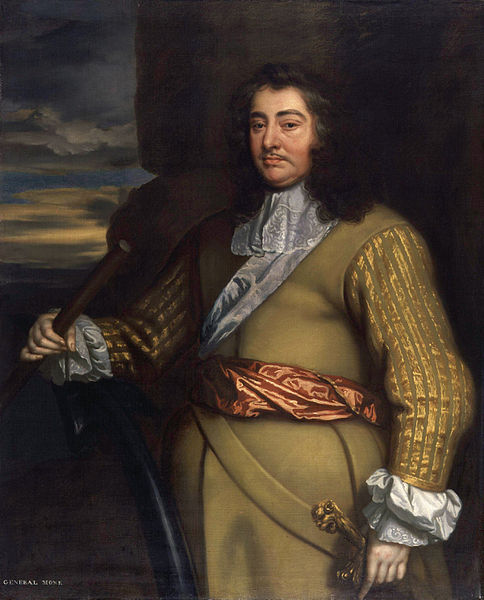 George Monck's march south caused Lambert's army to disintegrate and he was imprisoned in the Tower of London in March 1660. He made one final attempt to resist the Restoration of 1660 after escaping a month later, but his support had dwindled. He spent the remaining 24 years of his life imprisoned, first on Guernsey, and then on Drake's Island where he died in the winter of 1683-4 In December 1659 he appeared at the head of a body of Yorkshire gentlemen, and such was the influence of Fairfax's name and reputation that 1,200 horse quit Lambert's colours and joined him.Monk was born in 1608 at Great Potheridge House in Merton, Devon,
George Monck's march south caused Lambert's army to disintegrate and he was imprisoned in the Tower of London in March 1660. He made one final attempt to resist the Restoration of 1660 after escaping a month later, but his support had dwindled. He spent the remaining 24 years of his life imprisoned, first on Guernsey, and then on Drake's Island where he died in the winter of 1683-4 In December 1659 he appeared at the head of a body of Yorkshire gentlemen, and such was the influence of Fairfax's name and reputation that 1,200 horse quit Lambert's colours and joined him.Monk was born in 1608 at Great Potheridge House in Merton, Devon, second son of Sir Thomas Monk, a squire of a good Devon family but in straitened financial circumstances.Having assaulted the undersheriff of the county in revenge for a wrong done to his father, he was forced to go abroad.Becoming a soldier, he served as a volunteer in the expedition to Cádiz (1626),
second son of Sir Thomas Monk, a squire of a good Devon family but in straitened financial circumstances.Having assaulted the undersheriff of the county in revenge for a wrong done to his father, he was forced to go abroad.Becoming a soldier, he served as a volunteer in the expedition to Cádiz (1626), and the next year fought well at the siege of the Île de Ré (an abortive attempt to aid French Protestants in the city of La Rochelle).
and the next year fought well at the siege of the Île de Ré (an abortive attempt to aid French Protestants in the city of La Rochelle).
 George Monck's march south caused Lambert's army to disintegrate and he was imprisoned in the Tower of London in March 1660. He made one final attempt to resist the Restoration of 1660 after escaping a month later, but his support had dwindled. He spent the remaining 24 years of his life imprisoned, first on Guernsey, and then on Drake's Island where he died in the winter of 1683-4 In December 1659 he appeared at the head of a body of Yorkshire gentlemen, and such was the influence of Fairfax's name and reputation that 1,200 horse quit Lambert's colours and joined him.Monk was born in 1608 at Great Potheridge House in Merton, Devon,
George Monck's march south caused Lambert's army to disintegrate and he was imprisoned in the Tower of London in March 1660. He made one final attempt to resist the Restoration of 1660 after escaping a month later, but his support had dwindled. He spent the remaining 24 years of his life imprisoned, first on Guernsey, and then on Drake's Island where he died in the winter of 1683-4 In December 1659 he appeared at the head of a body of Yorkshire gentlemen, and such was the influence of Fairfax's name and reputation that 1,200 horse quit Lambert's colours and joined him.Monk was born in 1608 at Great Potheridge House in Merton, Devon, second son of Sir Thomas Monk, a squire of a good Devon family but in straitened financial circumstances.Having assaulted the undersheriff of the county in revenge for a wrong done to his father, he was forced to go abroad.Becoming a soldier, he served as a volunteer in the expedition to Cádiz (1626),
second son of Sir Thomas Monk, a squire of a good Devon family but in straitened financial circumstances.Having assaulted the undersheriff of the county in revenge for a wrong done to his father, he was forced to go abroad.Becoming a soldier, he served as a volunteer in the expedition to Cádiz (1626), and the next year fought well at the siege of the Île de Ré (an abortive attempt to aid French Protestants in the city of La Rochelle).
and the next year fought well at the siege of the Île de Ré (an abortive attempt to aid French Protestants in the city of La Rochelle).
In 1629 Monck went to the Netherlands, then a centre of warfare, and there he gained a high reputation as a leader and a disciplinarian. He fought bravely at the Siege of Breda (1637)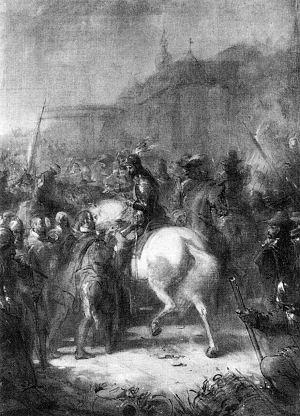 when he was first in the breach amongst his men. In 1638 however he threw up his commission in consequence of a quarrel with the civil authorities of Dordrecht,
when he was first in the breach amongst his men. In 1638 however he threw up his commission in consequence of a quarrel with the civil authorities of Dordrecht,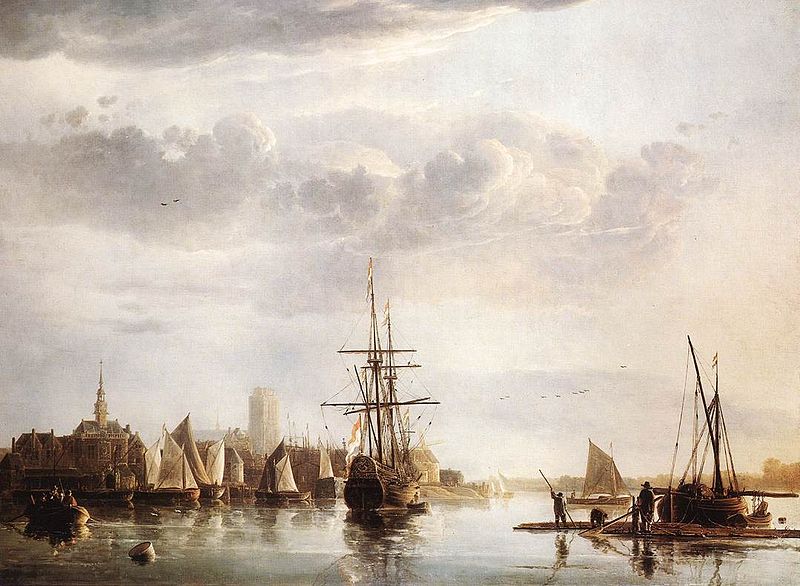 and returned to England. He obtained the lieutenant-colonelcy of the Earl of Newport's regiment
and returned to England. He obtained the lieutenant-colonelcy of the Earl of Newport's regiment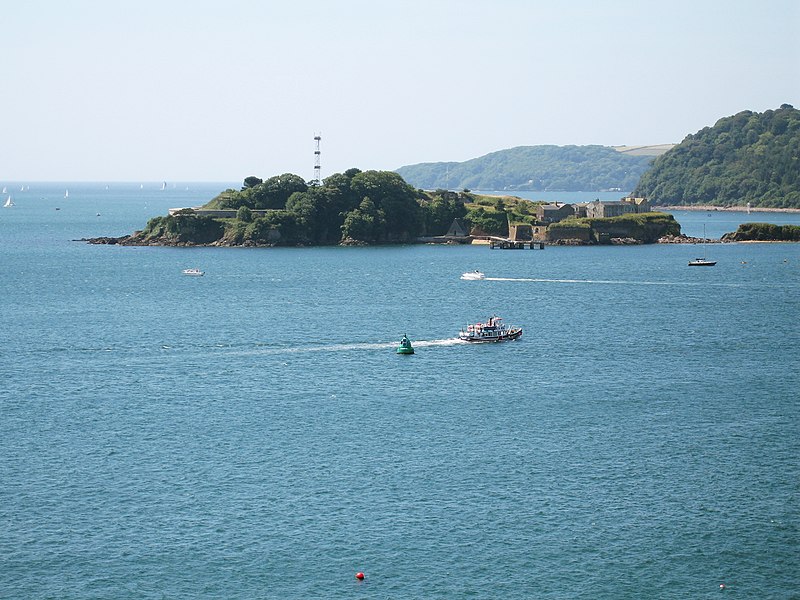
 when he was first in the breach amongst his men. In 1638 however he threw up his commission in consequence of a quarrel with the civil authorities of Dordrecht,
when he was first in the breach amongst his men. In 1638 however he threw up his commission in consequence of a quarrel with the civil authorities of Dordrecht, and returned to England. He obtained the lieutenant-colonelcy of the Earl of Newport's regiment
and returned to England. He obtained the lieutenant-colonelcy of the Earl of Newport's regiment
Drake's Island is a 6.5 acre (2.6 ha) island lying in Plymouth Sound, the stretch of water south of the city of Plymouth, Devon, England. The rocks which make up the island are volcanic tuff and lava, together with marine limestone of the mid-Devonian period
The first recorded name for the island was in 1135, when it was referred to as St Michael's, after the chapel erected on it. At some later date the chapel was rededicated to St Nicholas and the island adopted the same name. From the latter part of the 16th century the island was occasionally referred to as Drake's Island after Sir Francis Drake, the English privateer 
 who used Plymouth as his home port. Even well into the 19th century, maps and other references continued to refer to the island as St Nicholas's Island and it is only in about the last 100 years that this name has slipped into disuse and the name Drake's Island has been adopted.
who used Plymouth as his home port. Even well into the 19th century, maps and other references continued to refer to the island as St Nicholas's Island and it is only in about the last 100 years that this name has slipped into disuse and the name Drake's Island has been adopted.It was from here that Drake sailed in 1577, to return in 1580 having circumnavigated the world, and in 1583 Drake was made governor of the island. From 1549 the island began to be fortified as a defence against the French and Spanish, with barracks for 300 men being built on the island in the late 16th century.

For several centuries, the island remained the focal point of the defence of the three original towns that were to become modern Plymouth. In 1665 the Roundhead Robert Lilburne
 died imprisoned on the island. He had been sentenced to life imprisonment for his part in the Regicide of Charles I. A few years later John Lambert, a Roundhead
died imprisoned on the island. He had been sentenced to life imprisonment for his part in the Regicide of Charles I. A few years later John Lambert, a Roundhead  General, was moved to Drake's Island from Guernsey, where he had been imprisoned since 1662. He never regained his liberty, dying on Drake's Island in the winter of 1683.
General, was moved to Drake's Island from Guernsey, where he had been imprisoned since 1662. He never regained his liberty, dying on Drake's Island in the winter of 1683.In June 1774 the first recorded submarine fatality in history occurred north of Drake's Island, when a carpenter named John Day perished while testing a wooden diving chamber attached to the sloop Maria.
This was speedily followed by the breaking up of all Lambert's forces, and that day secured the restoration of the monarchy. In the subsequent elections, Fairfax was elected member of Parliament for Yorkshire, and was put at the head of the commission appointed by the House of Commons to wait upon Charles II, at the Hague and urge his speedy return. Fairfax provided the horse on which Charles rode at his coronation.
Fairfax had a taste for literature. He translated some of the Psalms, and wrote poems on solitude, the Christian warfare, the shortness of life, etc. During the last year or two of his life he wrote two Memorials which have been published – one on the northern actions in which he was engaged in 1642-1644, and the other on some events in his tenure of the chief command. At York and at Oxford he endeavoured to save the libraries from pillage, and he enriched the Bodleian with some valuable manuscripts. His correspondence, were edited by GW Johnson, and were published in 1848-1849 in four volumes .The metaphysical poet Andrew Marvell authored "Upon Appleton House, To My Lord Fairfax", nominally about Fairfax's home, but also his character as well as England during his era.

The remaining eleven years of the life of Lord Fairfax were spent in retirement at his seat in Yorkshire. Fairfax died at Nunappleton, and was buried at Bilbrough, near York.

He had married Hon. Anne de Vere, daughter of Horace Vere, 1st Baron Vere of Tilbury and Mary Tracy, on 20 June 1637. they had a daughter, Hon. Mary Fairfax (b. 30 Jul 1638 - d. 20 Oct 1704). who married George Villiers, 2nd Duke of Buckingham.
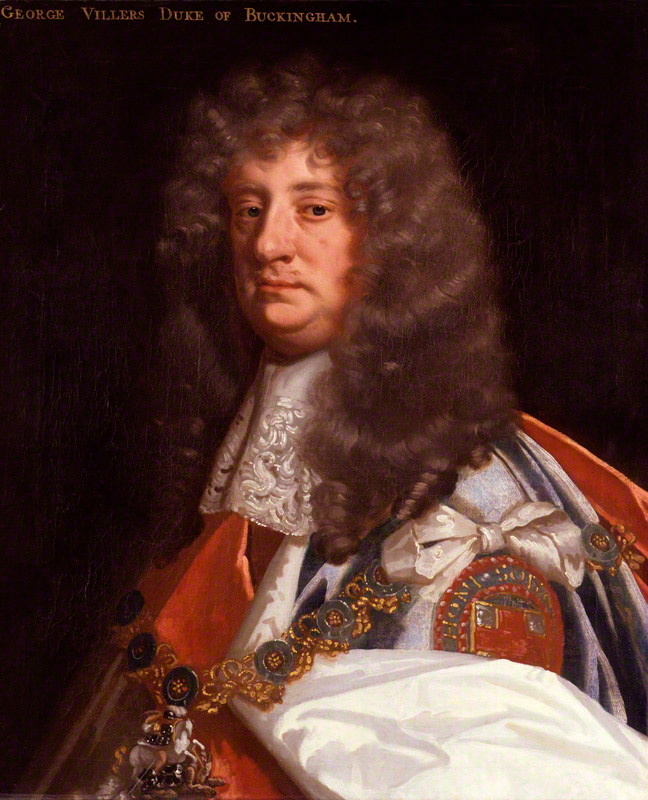
Sir Thomas was succeeded as Lord Fairfax by a cousin, Henry Fairfax, 4th Lord Fairfax of Cameron.
As a soldier he was exact and methodical in planning, in the heat of battle "so highly transported that scarce any one durst speak a word to him" (Whitelocke), chivalrous and punctilious in his dealings with his own men and the enemy. Honour and conscientiousness were equally the characteristics of his private and public character. But his modesty and distrust of his powers made him less effectual as a statesman than as a soldier, and above all he is placed at a disadvantage by being both in war and peace overshadowed by his associate Cromwell.

Naseby by Tony Kinnear.
Above are some superb examples of maybe the best plastic soldiers ever made.They are the really the essence and character of the British toy soldier in aesthetics and proportions. The size is the right one the perfect one. These are from Andy Harfield and cost only 4.25; if you buy plastic soldiers this bloke along with Lunar Tick are the best.No hassle just a good deal.They are both collectors as well.Note I use bloke instead of the American guy=WHY? Cos I'm English!
CROMWELL was in the right place at the right time.He had never been a soldier but rose to the occasion. He was England's only dictator and much written about him dwells on the bad not the good. THE ECW period has never been popular but it is a great theme.We can thank Callk to Arms for some superb plastic models, maybe the best created ever.
He was England's only dictator and much written about him dwells on the bad not the good. THE ECW period has never been popular but it is a great theme.We can thank Callk to Arms for some superb plastic models, maybe the best created ever.  Top left is Maros a great source for ECW figues and below it is a new piece from littlewars group. The Cromwell statue is outside Parliament in London. P:S by the way according to Richard Holmes of the BBC recent excavations of Naseby tell us that the Kings Guard died where they fought.This was in his war walks; the man who called the AWI a civil war.
Top left is Maros a great source for ECW figues and below it is a new piece from littlewars group. The Cromwell statue is outside Parliament in London. P:S by the way according to Richard Holmes of the BBC recent excavations of Naseby tell us that the Kings Guard died where they fought.This was in his war walks; the man who called the AWI a civil war.
 He was England's only dictator and much written about him dwells on the bad not the good. THE ECW period has never been popular but it is a great theme.We can thank Callk to Arms for some superb plastic models, maybe the best created ever.
He was England's only dictator and much written about him dwells on the bad not the good. THE ECW period has never been popular but it is a great theme.We can thank Callk to Arms for some superb plastic models, maybe the best created ever.  Top left is Maros a great source for ECW figues and below it is a new piece from littlewars group. The Cromwell statue is outside Parliament in London. P:S by the way according to Richard Holmes of the BBC recent excavations of Naseby tell us that the Kings Guard died where they fought.This was in his war walks; the man who called the AWI a civil war.
Top left is Maros a great source for ECW figues and below it is a new piece from littlewars group. The Cromwell statue is outside Parliament in London. P:S by the way according to Richard Holmes of the BBC recent excavations of Naseby tell us that the Kings Guard died where they fought.This was in his war walks; the man who called the AWI a civil war.




No comments:
Post a Comment